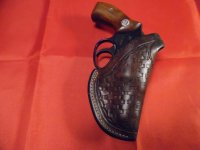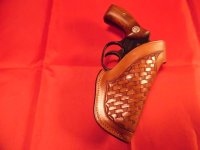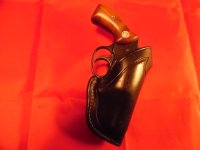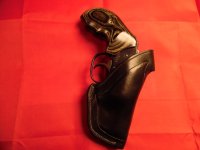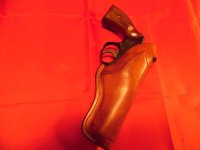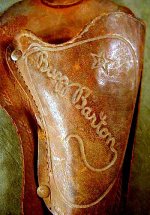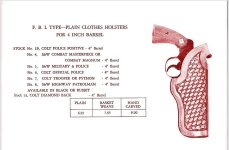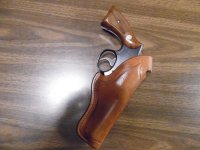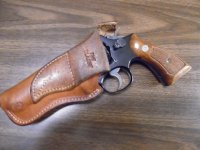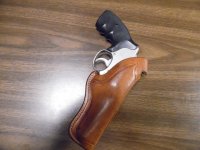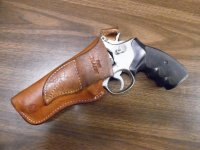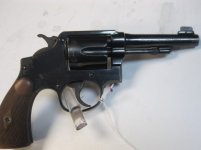Wally was born (1908) and raised in Massachusetts. He was making a living as a truck driver in 1943 when he went into the Army Air Corp. Age 34. Probably drafted.
He served in the Pacific, and was discharged at Kirtland Field in Albuquerque, N.M. in 1945. He apparantly liked it there because he stayed and joined the Albuquerque Police Department.
His first known holsters were made during his time in N.M. and were called his Wolf brand. The holster shown below left was made for F. M. Pitt Co.
Sometime in the early 1950s Wally migrated to California, settled in Monrovia, and went to work with the Monrovia Police Department. He continued making holsters like the one shown second from left below. It is called the Blazer, and was made for Geo. F. Cake Co.
In BLUE STEEL & GUNLEATHER, John Bianchi wrote: "Wally Wolfram, under whom the author served an apprenticeship in the early 1950s, is a retired police officer who served in both Albuquerque, N.M. and Monrovia, Ca. An excellent master leather craftsman and unparalleled perfectionist, Wally introduced many innovations in police leather during the 1940s and 1950s..."
FBI Agents and other lawmen were wearing suits, and often the spur on the hammer of their revolvers would shread the lining of their suit jackets. Some would put a rubber eraser over the spur to protect their jackets.
Some smart designer came up with a tab that kinda wrapped around the hammer to keep it from shreading the jacket linings. Some called it a hammer protector, but it didn't protect the hammer. It protected the clothing. Tex Shoemaker got it right. He called it a clothing protector. Some called it a hammer guard, a shroud, or a shield. I like the name the Texas Rangers used. They called it a "dog ear".
Back around 2012 I started collecting holsters with dog ears. I have about 2 dozen examples now by various makers. I have always wondered who the smart designer was. I suspect it was Wally Wolfram.
In 2014 I asked John Bianchi if he knew. John said: "Wally designed a hammer protector for small revolvers consisting of an extension of the front fold of an open top holster which came up to the level of the exposed hammer and provided limited protection or security. I strongly doubt any commercially successful models existed before that time."
turnerriver has said that his 1940 catalog has both the Barton Special and the Threeperson's style with "extended hammer cover". Does that mean the same thing as the dog ear? It has also been said that the dog ear didn't show up until the late 1940s and/or in the catalogs around 1950. Maybe it's just semantics?
Reminds me of Cool Hand Luke. Remember Strother Martin, as the prison warden, saying: "What we've got here is a failure to communicate."
If extended hammer cover means just that the leather goes up high enough to shield the hammer we could go clear back to the previous century. The old Mexican double loop holsters swallowed everything but the gun's handles.
I would like to see evidence that Myres and/or Heiser had what John Bianchi described as a hammer protector and I call a dog ear, before the late 1940s or 1950 catalogs. Until I see that evidence, I'm still believing Wally Wolfstram was that smart designer.
In the 1950s and 1960s Wally was making his little dog ear holster for Colt. My good friend, who you know as turnerriver, gave me one of Wally's Colt holsters. Shown 3rd from left.
In 1965 Bangor Punta acquired Smith and Wesson and set out to grow their business. They thought selling holsters would be a good idea, so
they bought Wally's business sometime between 1967 and 1969. Wally helped them for a while. His Blazer with S&W logo is shown 4th from left. Looks a lot like the one he had been making for Colt
5th from left is a larger Blazer with S&W logo made for a S&W K Frame with 4" barrel.
Bob Gould was an executive with Smith and Wesson, and was given the opportunity to buy the holster division. He, with a
partner did take over the holster division at the plant in North Carolina in 1979. Gould and Goodrich are still in business.
Wally returned to New Mexico for retirement, and passed away in 1988. And so ends the Wally Wolfram Saga.
He served in the Pacific, and was discharged at Kirtland Field in Albuquerque, N.M. in 1945. He apparantly liked it there because he stayed and joined the Albuquerque Police Department.
His first known holsters were made during his time in N.M. and were called his Wolf brand. The holster shown below left was made for F. M. Pitt Co.
Sometime in the early 1950s Wally migrated to California, settled in Monrovia, and went to work with the Monrovia Police Department. He continued making holsters like the one shown second from left below. It is called the Blazer, and was made for Geo. F. Cake Co.
In BLUE STEEL & GUNLEATHER, John Bianchi wrote: "Wally Wolfram, under whom the author served an apprenticeship in the early 1950s, is a retired police officer who served in both Albuquerque, N.M. and Monrovia, Ca. An excellent master leather craftsman and unparalleled perfectionist, Wally introduced many innovations in police leather during the 1940s and 1950s..."
FBI Agents and other lawmen were wearing suits, and often the spur on the hammer of their revolvers would shread the lining of their suit jackets. Some would put a rubber eraser over the spur to protect their jackets.
Some smart designer came up with a tab that kinda wrapped around the hammer to keep it from shreading the jacket linings. Some called it a hammer protector, but it didn't protect the hammer. It protected the clothing. Tex Shoemaker got it right. He called it a clothing protector. Some called it a hammer guard, a shroud, or a shield. I like the name the Texas Rangers used. They called it a "dog ear".
Back around 2012 I started collecting holsters with dog ears. I have about 2 dozen examples now by various makers. I have always wondered who the smart designer was. I suspect it was Wally Wolfram.
In 2014 I asked John Bianchi if he knew. John said: "Wally designed a hammer protector for small revolvers consisting of an extension of the front fold of an open top holster which came up to the level of the exposed hammer and provided limited protection or security. I strongly doubt any commercially successful models existed before that time."
turnerriver has said that his 1940 catalog has both the Barton Special and the Threeperson's style with "extended hammer cover". Does that mean the same thing as the dog ear? It has also been said that the dog ear didn't show up until the late 1940s and/or in the catalogs around 1950. Maybe it's just semantics?
Reminds me of Cool Hand Luke. Remember Strother Martin, as the prison warden, saying: "What we've got here is a failure to communicate."
If extended hammer cover means just that the leather goes up high enough to shield the hammer we could go clear back to the previous century. The old Mexican double loop holsters swallowed everything but the gun's handles.
I would like to see evidence that Myres and/or Heiser had what John Bianchi described as a hammer protector and I call a dog ear, before the late 1940s or 1950 catalogs. Until I see that evidence, I'm still believing Wally Wolfstram was that smart designer.
In the 1950s and 1960s Wally was making his little dog ear holster for Colt. My good friend, who you know as turnerriver, gave me one of Wally's Colt holsters. Shown 3rd from left.
In 1965 Bangor Punta acquired Smith and Wesson and set out to grow their business. They thought selling holsters would be a good idea, so
they bought Wally's business sometime between 1967 and 1969. Wally helped them for a while. His Blazer with S&W logo is shown 4th from left. Looks a lot like the one he had been making for Colt
5th from left is a larger Blazer with S&W logo made for a S&W K Frame with 4" barrel.
Bob Gould was an executive with Smith and Wesson, and was given the opportunity to buy the holster division. He, with a
partner did take over the holster division at the plant in North Carolina in 1979. Gould and Goodrich are still in business.
Wally returned to New Mexico for retirement, and passed away in 1988. And so ends the Wally Wolfram Saga.
Attachments
Last edited:

